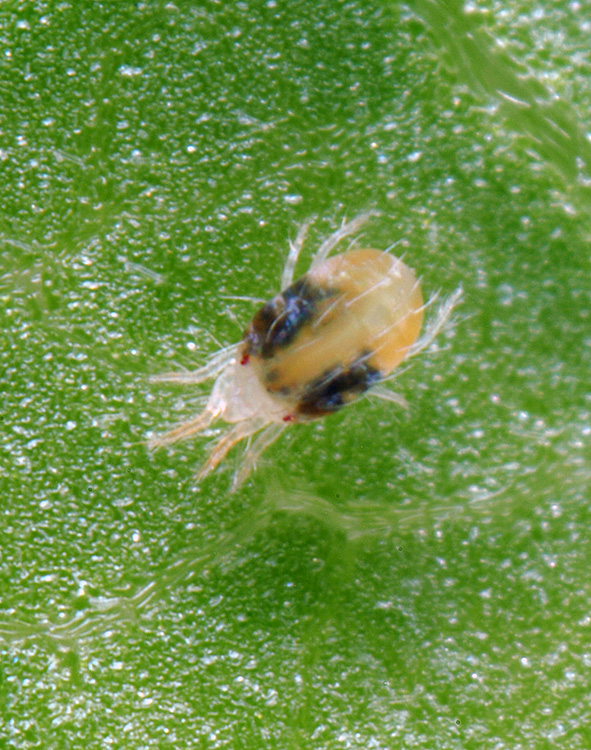- Tetranychus urticae
Taxobox
name = "Tetranychus urticae"

image_width = 250px
image_caption =
regnum =Animalia
phylum =Arthropoda
subphylum =Chelicerata
classis =Arachnida
subclassis =Acari
superordo =Acariformes
ordo =Prostigmata
subordo =Eleutherengona
unranked_familia =Raphignathae Verify source|date=January 2008
superfamilia =Tetranychoidea
familia =Tetranychidae
genus = "Tetranychus "
species = "T. urticae"
binomial = "Tetranychus urticae"
binomial_authority = C.L. Koch, 1836"Tetranychus urticae" (an animal with over 60 common names, including red spider mite and two-spotted spider mite) is one of many species of plant-feeding
mite s found in dry environments, and generally considered a pest. It is the most widely known member of the familyTetranychidae orSpider mite s."T. urticae" is extremely small, barely visible with the naked eye as reddish or greenish spots on leaves and stems; the adults measure about 0.5 mm. The red spider mite, which can be seen in
greenhouse s and tropical and temperate zones spinning a fine web on and under leaves. The red spider mite is extremelypolyphagous ; it can feed on hundreds of plants, including mostvegetable s and food crops (peppers,tomatoes ,potato es,bean s,corn , strawberries) andornamentals :rose s, etc. It lays its eggs on the leaves, and it poses a threat to hostplant s by sucking cell contents from the leaves cell by cell, leaving very tiny, pale spots or scars where the green epidermal cells have been destroyed. Although the individual lesions are very small, commensurate with the small size of the mites, the frequently-observed attack of hundreds or thousands of spider mites can cause thousands of lesions and thus can significantly reduce the photosynthetic capability of plants, greatly reducing their production of nutrients, sometimes even killing the plants. Although this way of feeding could spread plantvirus es, this is considered of secondary importance.During the summer, "T. urticae" has a greenish brown appearance with two darker spots, but as winter approaches it gains a strong red color. Some populations are pemanently greenish or reddish, and these are considered different species of "Tetranychus" by some authorities.
Its natural predator, "
Phytoseiulus persimilis ", commonly used as abiological control method, is one of many predaceous mites which prey exclusively or mainly on spider mites.External links
* [http://www.memx.com/movie_gallery.htm MEMS Movie Gallery] , Spider mite used for demonstrating
MEMS technology
* [http://creatures.ifas.ufl.edu/orn/twospotted_mite.htm twospotted spider mite] on theUF / IFAS Featured Creatures Web site
Wikimedia Foundation. 2010.
